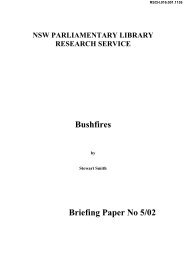1 CONDITIONS ON 7 FEBRUARY - 2009 Victorian Bushfires Royal ...
1 CONDITIONS ON 7 FEBRUARY - 2009 Victorian Bushfires Royal ...
1 CONDITIONS ON 7 FEBRUARY - 2009 Victorian Bushfires Royal ...
Create successful ePaper yourself
Turn your PDF publications into a flip-book with our unique Google optimized e-Paper software.
Conditions on 7 February<br />
Figure 1.1 Rainfall deciles – Victoria, 1 February 1997 to 31 January <strong>2009</strong><br />
Lowest on record<br />
Mildura<br />
Hay<br />
Goulburn<br />
Very much below average<br />
Below average<br />
Average<br />
Ouyen<br />
Swan Hill<br />
Deniliquin<br />
Wagga Wagga<br />
Canberra<br />
Horsham<br />
Bendigo<br />
Echuca<br />
Benalla<br />
Albury<br />
Cooma<br />
Perisher Valley<br />
Omeo<br />
Casterton<br />
Portland<br />
Ballarat<br />
Geelong<br />
Warrnambool<br />
Cape Otway<br />
Melbourne<br />
Bairnsdale<br />
Latrobe Valley<br />
Wonthaggi<br />
Wilsons Promontory<br />
Source: Exhibit 22 – Statement of Williams, Annexure 1. 12<br />
Prolonged drought combined with heatwave conditions are strong predictors of severe bushfire risk, the former<br />
leading to increases in plant deaths and the thinning of plant materials and the latter increasing the combustibility<br />
of plants. Warming temperatures and reduced rainfall diminish the available moisture and place greater stress on<br />
vegetation. When fires do occur these conditions generally mean that burning will be more severe. 13<br />
Weather is a major factor affecting the spread of a fire. The four basic elements of fire weather are air temperature,<br />
relative humidity, wind speed and direction, and atmospheric stability. 14 Just before 7 February these elements<br />
were at their most extreme in Victoria, some setting records for the state.<br />
Wind is one of the critical factors affecting the shape, direction, rate of spread and behaviour of a fire. It supplies<br />
oxygen to encourage burning; removes ash, smoke and moisture from fuels in the area; and angles the flames, hot air<br />
and gases over the unburnt fuel ahead of the fire, pre-heating the fuel and helping the fire spread more rapidly. Wind can<br />
also lift burning materials such as bark and other embers and carry them ahead of the main fire, where spot fires can<br />
start. The stronger the wind, the faster and further a fire will spread. 15<br />
Hot northerly or north-westerly winds are an indicator of the potential for critical fire weather. These winds originate from<br />
high pressure systems that enter the east of the Australian continent and travel across Australia, through the Central<br />
Australian desert. Here they dry out and eventually lead to a south-westerly wind change. 16 Figure 1.2 shows the effect<br />
of wind strength on a fire’s shape.<br />
11
















